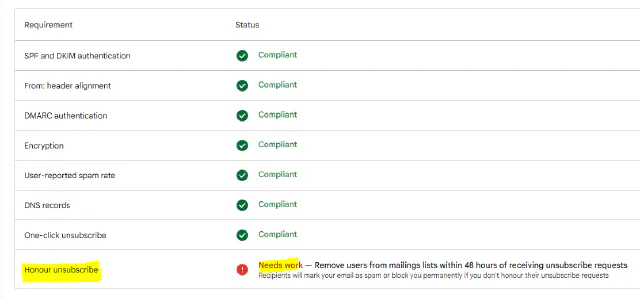Yahoogle
Gmail says your unsubscribe "Needs work"
- steve
- Jul 11, 2025

Needs work?
We’ve written about RFC 8058 “one-click” unsubscribe and how it’s part of the requirements for bulk senders wanting to deliver mail to the major consumer mailbox providers.
Read MoreSending domains and hostnames
- steve
- Jul 12, 2024
Lots of times I see someone asking a question and they talk about their sending domain. And it’s sometimes not 100% clear which domain they mean by that – and when we’re talking about alignment and reputation it can make a difference. So here’s a list of (some of?) the different places a mailserver uses a domain.
Read MoreDeliverability is Collaborative
- steve
- Jun 18, 2024
Mailbox providers want happy recipients

Mailbox providers want their users to be happy with the mail they receive and the service they get. That’s driven by stark business reasons: acquiring new users is costly, happy users bring in revenue – whether directly, or indirectly via advertising – and their word of mouth helps bring in more users, and hence more revenue. That’s still true when the email service is bundled as part of a larger package, such as broadband service or domain registration.
Read MoreOne-click unsubscribe
- steve
- Jan 31, 2024
The worst thing about the yahoogle requirements has been their use of the term “one-click unsubscribe”. It’s an overloaded term that’s being used here to mean RFC 8058 in-app unsubscription. That’s a completely different thing to what one-click unsubscription has been used to mean for decades, often in the context of complying with legal requirements around unsubscription.
Read MoreDon’t trust Gmail’s Show Original
- steve
- Jan 17, 2024
It’s not always easy to know what the actual headers and body of an email as sent look like. For a long time accepted wisdom was that you could send a copy to your gmail account, and use the Show Original menu option to, well, see the original message as raw text.
Read MoreAre you a grown-up sender?
- steve
- Jan 5, 2024
Yes, it’s another yahoogle best practices post.
Google divide their requirements for senders into those sending more than 5,000 messages a day, and those sending less.
Read MoreYahoogle FAQs
- steve
- Jan 4, 2024
Just a very, very short post with links to the Yahoo and Google requirements FAQs. Given I can’t ever remember them I’m guessing lots of y’all can’t either.
Read MoreAnswers to your questions about the new Yahoo and Google technical requirements
- laura
- Jan 3, 2024
On January 9th at 6pm GMT, 1pm EST and 10am PST I’ll be speaking with Nout Boctor-Smith of Nine Lives Digital about the new Yahoo and Google technical requirements.
Read MoreAbout My Email
- steve
- Jan 2, 2024
Happy 2024, everyone!
We’ve released a shiny new tool to let folks self-check a lot of common questions we see about email requirements.
Read MoreYahoogle Requirements Update
- steve
- Nov 9, 2023
Since I wrote about it last month the requirements for bulk senders to Yahoo and Google have changed a little.
Read More